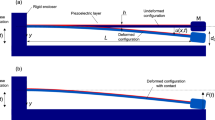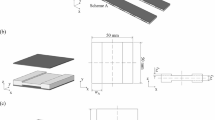Abstract
In this paper, two preliminary designs of morphing wings based on multistage displacement amplification mechanisms (DAMs) are proposed, and their characteristics are evaluated by analytical modeling and experiments. The first design of a morphing wing (Re-MOW) is based on two-stage rhombus-type DAMs. In the first stage, a retraction-type electrothermal actuator (ReACT) consisting of a diamond-shaped displacement amplification structure (DAS) and an actuating bar that is thermally expanded by thin-film heaters is applied. In the second stage, the retraction displacement of the ReACT is again amplified by wings with rhombic DAS. The second morphing wing design (Ex-MOW) is based on a chevron and rhombus-shaped DAS. In the first stage, an extension-type electrothermal actuator (ExACT) operated by a diamond-shaped DAS consisting of a pair of V-shaped chevron beams and supporting bars is applied. Similar to the Re-MOW, the deformation of the ExACT is again amplified by the four flat wings assembled in a rhombus in the second stage. In the analysis results, it was deduced that the wing thicknesses of Re-MOW and Ex-MOW were amplified by 22.6 times and 21.2 times, respectively, compared to the thermal expansion length of the actuating bar and chevron beam. Afterward, the morphing wings were fabricated using a 3D printer with polyamide as the material, and their amplification ratio and total deformation as temperature and time are measured at various input voltages. In the experimental results, the thickness changes of the Re-MOW and Ex-MOW reached approximately 14 and 32 % of the initial total thickness of the wing, respectively.
Similar content being viewed by others
References
N. I. Ismail, Aerodynamic performances of twist morphing MAV wing, Ph.D. Thesis, Universiti Teknologi MARA (2015).
J. Sun, Q. Guan, Y. Liu and J. Leng, Morphing aircraft based on smart materials and structures: A state-of-the-art review, J. Intell. Mater. Syst. Struct., 27 (17) (2016) 2289–2312, doi: https://doi.org/10.1177/1045389X16629569.
S. Barbarino, O. Bilgen, R. M. Ajaj, M. I. Friswell and D. J. Inman, A review of morphing aircraft, J. Intell. Mater. Syst. Struct., 22 (9) (2011) 823–877, doi: https://doi.org/10.1177/1045389X11414084.
A. Suman, A. Fortini and M. Merlin, A shape memory alloy-based morphing axial fan blade: functional characterization and perspectives, Energy Procedia, 82 (2015) 273–279, doi: https://doi.org/10.1016/j.egypro.2015.12.033.
D. J. Hartl, D. C. Lagoudas, F. T. Calkins and J. H. Mabe, Use of a Ni60Ti shape memory alloy for active jet engine chevron application: I. Thermomechanical characterization, Smart Mater. Struct., 19 (1) (2009) 15020, doi: https://doi.org/10.1088/0964-1726/19/1/015020.
A. Nespoli, S. Besseghini, S. Pittaccio, E. Villa and S. Viscuso, The high potential of shape memory alloys in developing miniature mechanical devices: A review on shape memory alloy mini-actuators, Sensors Actuators A Phys., 158 (1) (2010) 149–160, doi: https://doi.org/10.1016/j.sna.2009.12.020.
J. Leng, X. Lan, Y. Liu and S. Du, Shape-memory polymers and their composites: Stimulus methods and applications, Prog. Mater. Sci., 56 (7) (2011) 1077–1135, doi: https://doi.org/10.1016/j.pmatsci.2011.03.001.
Y. Liu, H. Du, L. Liu and J. Leng, Shape memory polymers and their composites in aerospace applications: A review, Smart Mater. Struct., 23 (2) (2014) 23001, doi: https://doi.org/10.1088/0964-1726/23/2/023001.
Y. Bar-Cohen, Electroactive polymers: current capabilities and challenges, Proc. SPIE 4695, Smart Structures and Materials 2002: Electroactive Polymer Actuators and Devices (EAPAD), San Diego, USA (2002) doi: https://doi.org/10.1117/12.475159.
M. Shahinpoor, Y. Bar-Cohen, J. O. Simpson and J. Smith, Ionic polymer-metal composites (IPMCs) as biomimetic sensors, actuators and artificial muscles: A review, Smart Mater. Struct., 7 (6) (1998) R15–R30, doi: https://doi.org/10.1088/0964-1726/7/6/001.
F. K. Straub, D. K. Kennedy, A. D. Stemple, V. R. Anand and T. S. Birchette, Development and whirl tower test of the SMART active flap rotor, Proc. SPIE 5388, Smart Structures and Materials 2004: Industrial and Commercial Applications of Smart Structures Technologies (2004) https://doi.org/10.1117/12.562645.
B. Grohmann, C. Maucher and P. Jänker, Actuation concepts for morphing helicopter rotor blades, ICAS-Secretariat - 25th Congr. Int. Counc. Aeronaut. Sci. 2006, 4 (2006) 2199–2208.
F. K. Straub et al., Smart material-actuated rotor technolnnogy - SMART, J. Intell. Mater. Syst. Struct., 15 (4) (2004) 249–260, doi: https://doi.org/10.1177/1045389X04042795.
A. M. Pankonien, C. T. Faria and D. J. Inman, Synergistic smart morphing aileron: experimental quasi-static performance characterization, J. Intell. Mater. Syst. Struct., 26 (10) (2014) 1179–1190, doi: https://doi.org/10.1177/1045389X14538530.
A. M. Pankonien, K. Duraisamy, C. T. Faria and D. Inman, Synergistic smart morphing aileron: aero-structural performance analysis, 22nd AIAA/ASME/AHS Adaptive Structures Conference, American Institute of Aeronautics and Astronautics (2014).
J. L. Pinkerton and R. W. Moses, A Feasibility Study to Control Airfoil Shape Using THUNDER, NASA Technical Memorandum 4767, NASA (1997).
R. Barrett and J. Stutts, Development of a piezoceramic flight control surface actuator for highly compressed munitions, 39th AIAA/ASME/ASCE/AHS/ASC Structures, Structural Dynamics, and Materials Conference and Exhibit, American Institute of Aeronautics and Astronautics (1998).
S. Shao, M. Xu, S. Zhang and S. Xie, Stroke maximizing and high efficient hysteresis hybrid modeling for a rhombic piezoelectric actuator, Mech. Syst. Signal Process., 75 (2016) 631–647, doi: https://doi.org/10.1016/j.ymssp.2015.12.007.
J. Park, H. Lee, H. Kim, H. Kim and D. Gweon, Note: development of a compact aperture-type XYθz positioning stage, Rev. Sci. Instrum., 87 (3) (2016) 36112, doi: https://doi.org/10.1063/1.4945307.
M. Muraoka and S. Sanada, Displacement amplifier for piezoelectric actuator based on honeycomb link mechanism, Sensors Actuators A Phys., 157 (1) (2010) 84–90, doi: https://doi.org/10.1016/j.sna.2009.10.024.
A. Potekhina and C. Wang, Review of electrothermal actuators and applications, Actuators, 8 (4) (2019) doi: https://doi.org/10.3390/ACT8040069.
A. V Popov, L. T. Grigorie, R. Botez, M. Mamou and Y. Mébarki, Closed-loop control validation of a morphing wing using wind tunnel tests, J. Aircr., 47 (4) (2010) 1309–1317, doi: https://doi.org/10.2514/1.47281.
Acknowledgments
This study was conducted with the support of the National Research Foundation of Korea through the funding of the Ministry of Science and ICT in 2022 (NRF-2022R1F1A1072294).
Author information
Authors and Affiliations
Corresponding author
Additional information
Yehrin Jo received a B.S. degree from Kyungil University in 2020 and a M.S. degree from Kyungil University in 2022 as a microactuator based on mechanical metamaterials. Since then, she has been conducting research on the metamaterial manufacturing (printing, synthetic) process at Center for Advanced Meta-Materials (CAMM).
Yongdae Kim is currently an Associate Professor at the School of Mechanical and Automotive Engineering, Kyungil University (KIU) in Republic of Korea. Prior to his recent appointment at the KIU, he was a Senior Researcher at the Agency for Defense Development. Prof. Yongdae Kim received the B.S. degree in Mechanical Engineering from Chung-Ang University in 2005 and the M.S. degree and the Ph.D. degree in Aerospace Engineering from KAIST in 2007 and 2010, respectively. His areas of interests include harsh environment micro- and small-scale sensors and actuators.
Rights and permissions
About this article
Cite this article
Jo, Y., Kim, Y. Two types of morphing wing designs based on multistage displacement amplification mechanisms. J Mech Sci Technol 37, 2993–3004 (2023). https://doi.org/10.1007/s12206-023-0525-3
Received:
Revised:
Accepted:
Published:
Issue Date:
DOI: https://doi.org/10.1007/s12206-023-0525-3




